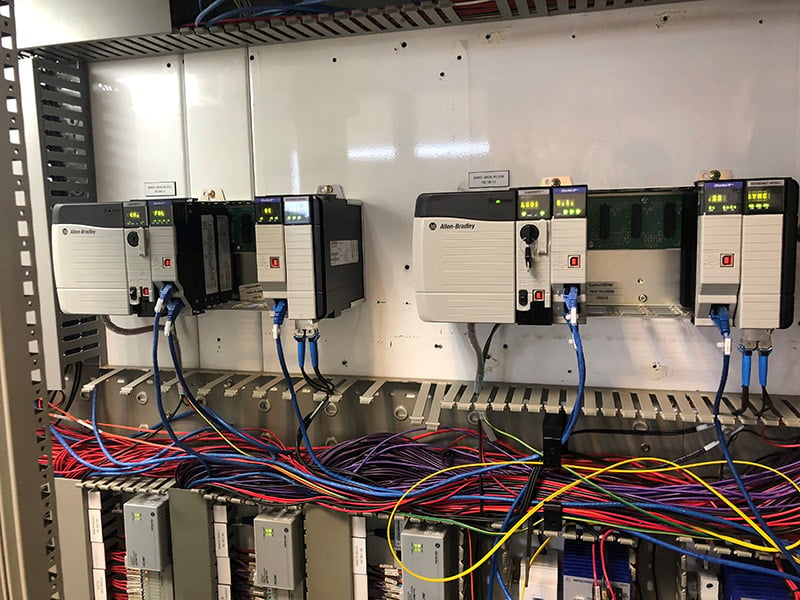SAGE Automation was contracted by SA Water to upgrade the site facilities. Barry Higham, senior project manager, SAGE Automation, stated that as a first step, design workshops were conducted to assess the current functionality and then establish what was required moving forward. The workshops also provided a valuable opportunity to help establish a collaborative culture within the integrated team, which lent itself to an outcome-focused solution.
At the heart of the plant’s existing control system were legacy PLC-5 controllers that are no longer supported but were responsible for the automatic control of wastewater treatment that complies with the Environment Protection Authority’s (EPA) requirements for a licensed wastewater treatment facility.
Given the importance of maintaining uptime at the plant and the risks involved with legacy equipment, the PLC-5 controllers were upgraded to Allen-Bradley® ControlLogix® with the provision for redundancy. PowerFlex® drives were used to power the pumps and the field devices were controlled using the Allen-Bradley CompactLogix™ controllers. “Our scope was to fully rewrite the PLC logic for all required functionality and install new redundant ControlLogix processors,” said Higham.
As products age and give way to new technologies, Rockwell Automation works with customers to help them meet the demand to innovate and help to optimise performance. The PLC-5 Control System is among the largest installed base of any one control platform. However, spare parts, repaired units, and engineers that have experience with these controllers are becoming increasingly scarce.
As part of the update, the legacy ControlNet adapters for the Flex® I/O were replaced with Ethernet/IP adapters. “This simplified the process and reduced project risks as the I/O wiring was not impacted or interfered with for this network change. By using ControlLogix and CompactLogix controllers, we were able to develop the new PLC logic in the RSLogix 5000 environment. Using Add On Instructions that were defined during earlier stages of the upgrade works, there was no need to develop new code for subsequent stages of the upgrade, which proved to be a great timesaver. FactoryTalk® View was used for the HMIs, providing premier integration and the ability to see the entire plant,” explained Higham.
 The plant's legacy PLC-5 controllers were upgraded to Allen-Bradley ControlLogix with the provision for redundancy.
The plant's legacy PLC-5 controllers were upgraded to Allen-Bradley ControlLogix with the provision for redundancy.
Maintaining wastewater treatment during the upgrade
A spokesperson from SA Water explained that a key challenge for the project from inception was the ability to transition from the old control system to the new.
“Apart from the complexity behind the wastewater treatment process, transitioning from the old to the new system posed a high risk in terms of plant performance and operability. In order to avert a potential sewage overflow, the cutover process was meticulously planned, reviewed, quality assured and monitored.”
As the entire wastewater treatment plant was live, the complex upgrade was carried out on a running system. To avoid downtime during the upgrade, the PLC-5 controllers essentially became a gateway to allow the flexibility for easy roll back and roll forward as required. “We decided to encode everything by transferring all the Flex™I/O modules that were previously on ControlNet to Ethernet/ IP. We sequentially checked the coding related to devices connected to each card was correct. This allowed us to complete the upgrade with no significant interruption to wastewater treatment,” said Higham.
 A complex upgrade carried out while the wastewater treatment plant was live.
A complex upgrade carried out while the wastewater treatment plant was live.
One of the biggest challenges encountered during this project was deciding on how to respond to a PLC failure. As there are many areas of the plant linked to each other, opening and closing valves has sequential consequences for downstream processes. To address this, each and every possible scenario was considered and based on this, the resulting outputs decided.
For improved uptime, the plant can be separated into two separate plants with a redundant link between the two. Therefore, if there is an issue with a switch in one part of the plant, connection can be maintained. The diagnostics are available via the controllers through Ethernet/IP and alarming is notified through SCADA so any problems can be fixed with ease to minimise downtime at the plant.









